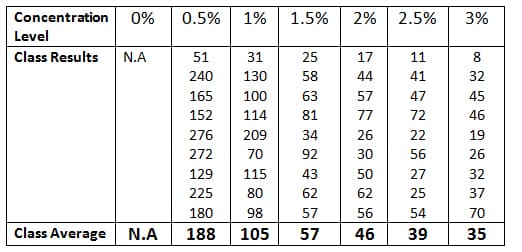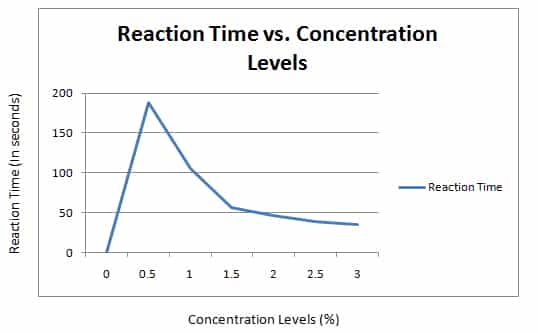An enzyme is described as a biological catalyst that speeds up the rate of a chemical reaction. In order for an enzyme to perform its given job, it needs what is known as a substrate to bind to the active site of the enzyme so that the enzyme can speed up the reaction of the substrate. In this given experiment, it was to be tested what impact the concentration level of the substrate will have on the reaction rate.
The enzyme catalase, found in potato juice, was used for the catalyst along with a substrate known as hydrogen peroxide (H2O2). The job of catalase in this experiment was to accelerate the breakdown of hydrogen peroxide into water and oxygen gas. After looking and recording how different concentrations of a substrate affect the enzyme’s activity, the results were put into a chart and graph to show our observations.
The given chart and graph show the different concentration levels of the substrate that were used, along with the time it took for the reaction to occur.


An enzyme is supposed to speed up the reaction, but our observations show that the concentration of the substrate also had an effect on how fast the reaction could occur. When there were zero concentrates of hydrogen peroxide, meaning the solvent was only water, there was no reaction with the catalase. As the concentration of hydrogen peroxide increases, the rate of the reaction began to increase.
This occurred because adding amounts of hydrogen peroxide gave the catalase the opportunity to break down the hydrogen peroxide, whereas when there was no H2O2 present, there was nothing for the catalase to react with. The catalase needs its specific substrate to bind with in order for a reaction to occur.
The shape of the chart itself shows the decrease in needed reaction time, proving our analysis to be correct. If we had continued to test out different concentrations of our substrate, the reaction time would have continued to decrease until the enzyme hit what is known as the saturation level, which means all the enzymes are working and the reaction cannot continue to increase because there is no location at that time for the substrates to bind to. For this experiment, the saturation point was not reached but could have if the experiment had continued.
From our observations, it could be concluded that the higher the concentration of substrate, Hydrogen Peroxide there was in the reaction, the less time was needed for the reaction to occur.
